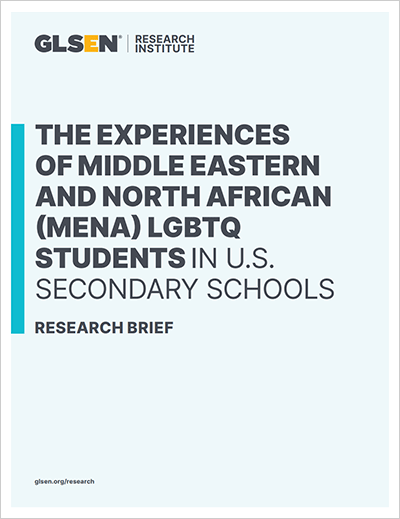
Experiences of MENA LGBTQ Students in U.S. Secondary Schools

The Experiences of Middle Eastern and North African (MENA) LGBTQ Students in U.S. Secondary Schools
Over the past 20 years, GLSEN’s research has established that schools are not safe or welcoming spaces for LGBTQ youth, who face hostile school climates due to their sexual orientation, gender, gender expression, or race/ ethnicity. Further, prior research has indicated that experiences of racism, homophobia, and transphobia in U.S. schools are prevalent among LGBTQ youth of color. Prior research on LGBTQ youth of color in general has shown that schools nationwide are hostile environments for these students, where they experience victimization and discrimination based on race, sexual orientation, gender identity, or all of the above simultaneously. The specific experiences of Middle Eastern and North African (MENA) LGBTQ students are less known; there has been little research on the school experiences of Middle Eastern and North African (MENA) students in general, with a particular paucity of literature surrounding their overlapping sexual orientation, gender, gender expression, and race/ ethnicity identities.
To this end, because LGBTQ student and LGBTQ students of color are not monolithic populations, this report focuses solely on the school experiences of MENA LGBTQ students. More specifically, this brief describes the school experiences of MENA LGBTQ students in secondary schools in the U.S. by examining:
- MENA students’ feelings of safety at school based on personal characteristics, hearing biased remarks from other students, experiences with victimization based on personal characteristics, and experiences with school discipline;
- Changes in hearing biased remarks and experiences with victimization over time for MENA students;
- The impact of experiences with victimization based on personal characteristics on MENA students’ school engagement, educational outcomes, and psychological well-being;
- MENA students’ access to school supports; and
- Whether these supports provide benefits to MENA students.
Further, this brief explores whether there are differences between MENA LGBTQ students and other LGBTQ students in hostile school climate experiences, school engagement, educational outcomes, psychological well-being, and access to resources at school.
DOWNLOAD RESEARCH BRIEF >
For additional reading on LGBTQ youth of color, please see our Erasure and Resilience series of reports on LGBTQ students of color that examines the school experiences of Latinx, AAPI, Black, and Native and Indigenous LGBTQ youth.
